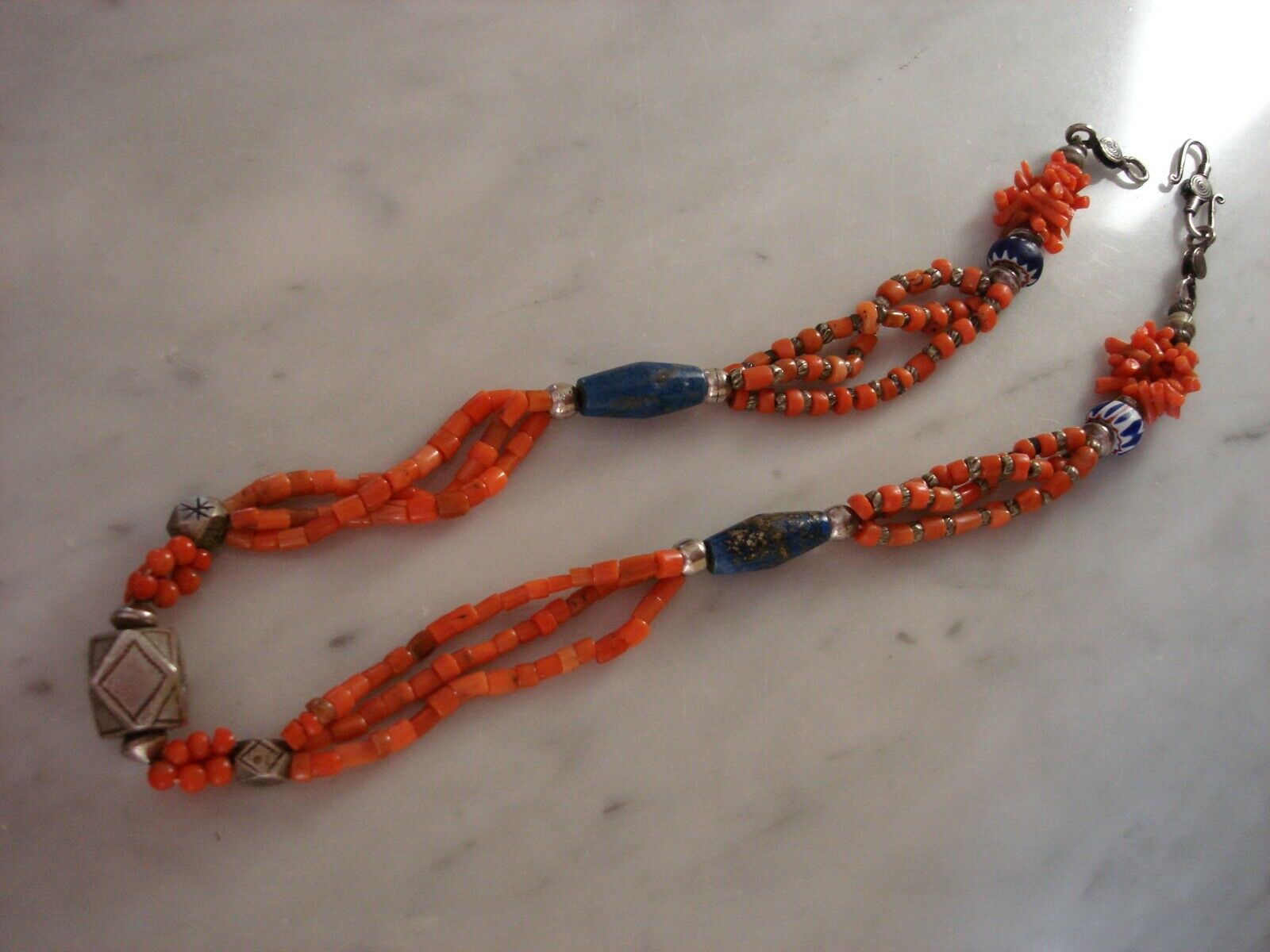-40%
Idar Oberstein Talhakimt carnelian Berber copal Amber and Hebron beads necklace.
$ 71.28
- Description
- Size Guide
Description
Idar Oberstein Talhakimt huge carnelian Tuareg Tanfout Berber Pendant with copal cognac Amber and Hebron beads on an adjustable leather cord necklace.Beautiful Berber handmade piece made in a thin adjustable brown leather cord.
Adjustable from 32” down to any size you like. You can wear it long like on the mannequin or as a choker to fit any style or taste.
The leather cord is 1.5mm in thickness.
The huge carnelian talhakimt Berber Pendant measures 4” in height by 1 3/4” in width.
There are 2 small copal Amber beads measuring 14mm.
The large deep Cognac copal Amber beads measured approximately 28mm.
The blue Hebron bead is approximately 20mm.
The green Hebron bead Is approximately 16mm.
Talhakimt pendants were produced by both the French and Czech-Bohemian bead industries during the trade bead era, which peaked between the late 19th and early 20th centuries. The Czech versions were made from molded glass, and came in a variety of colors, including green, red and blue.
French Talhakimts were the brainchild of Jean-Felix Bapterosses, a pioneering button and bead maker. As a young man, Bapterosses traveled to England, where he studied the “Prosser” technique of molding and firing a paste to produce a hard porcelain-like material. Bapterosses returned to France and, after making several improvements to the technique, implemented it at his button and bead factory in Briare.
Talhakimt pendants were one of the many items manufactured at the factory.
French Talhakimts, along with their Czech-Bohemian counterparts, were exported mainly to West Africa, where they were believed to have amuletic properties. Mauritanian women wore them in elaborate headdresses, plaited into long braids.
The most spectacular examples of this kind of adornment were found among the dancers of the Guedra, a traditional dance in which women displayed their love for men in ritual form.
Talhakimt pendants such as this were exported to West Africa for the bead trade throughout the course of the 20th century. Originally produced in the bead workshops of Bohemia from Czech Glass, they were molded using the Prosser method and coveted by tribal peoples as a talisman to ward off the evil eye and as part of traditional costumes. This is an original piece. Get your piece of history today!
Carnelian is said to aid health, long life and good fortune. It is also said to help one fulfil ones innermost wishes if worn near the heart. Warming and cleansing the blood and kidneys this stone works well in the orange and yellow. This stone can also be used to stimulate appetite, passion, emotions and physical energy.
Like the unexpected fire of a sunset, or the first flash of autumn brilliance, Carnelian captivates. Its bold energy brings a rush of warmth and joy that lingers, stimulating and empowering. Known as a stone of motivation and endurance, leadership and courage, Carnelians have protected and inspired throughout history.
A glassy, translucent stone, Carnelian is an orange-colored variety of Chalcedony, a mineral of the Quartz family. Its color varies from pale pinkish-orange to a deep rusty brown, though it is most known for its brilliant orange and red-orange crystals. Its name comes from a Latin word meaning “flesh.”
In antiquity, as well as today, Carnelian is believed to help timid speakers become both eloquent and bold. Ancient Warriors wore Carnelian around their neck for courage and physical power to conquer their enemies. In Egypt it was worn by master architects to show their rank of builder, and alchemists of the Middle Ages used it as a boiling stone to activate the energy of other Chalcedonies.
The ancient Egyptians called Carnelian “the setting sun.” In its orange hues, they identified it with the receptive or passive female energies, and associated it with the fertile menstrual blood of the mother goddess, Isis. In its red, red-orange to reddish brown shades, they considered it the active male energy stone, recognized by its glowing vibrant color. Carnelian is traditionally worn to enhance passion, love, and desire.
Antique glass Hebron beads from the African Trade. These date back to anywhere from the 1800's. Beautiful and rare shades of green and blue.
Take a look at these amazing Hebron beads, brought here from Africa. These bead are sometimes referred to as "Kano Beads". They are said to have been made in Hebron before 1800. This unusual green color is more rare.
Located at the southwestern edge of Germany, ldar-Oberstein is the historic stone-cutting of Europe.
The industry was originally based on local deposits of agate, jasper, rock crystal and amethyst but beginning in the 19th century, all kinds ofrough gemstones began to be imported from around the world.
A great deal of this success was based on the manufacture of agate beads.
This not only discusses the history of the industry, but also provides in-depth information concerning the techniques and tools used in beadmaking and drilling.
Idar-Oberstein is a small town of roughly 50,000 inhabitants in a narrow, picturesque valley in the HunsrUck Mountains on the very western edge of Germany. It is located in the state of Rheineland- Pfalz, about 110 km southwest of Frankfurt am Main.
Idar and Oberstein were originally two separate towns, each conducting its own unique business in the gem and jewelry industries. Idar was the gem cutting center and Oberstein was known for its jewelry manufacturing.
Oberstein has long been only one of many jewelry-manufacturing centers in Europe, but Idar has had few rivals in the gem-cutting field. In 1933 The two towns were consolidated into one.
The gem-cutting region of Idar-Oberstein is now made up of the city itselfand many small hamlets that dot the surrounding hills.
Idar-Oberstein is widely recognized within the gemstone industry as the most significant European cutting center for gemstones other than diamonds.
Records show that gem cutting in the general region dates back to the 14th century.




















